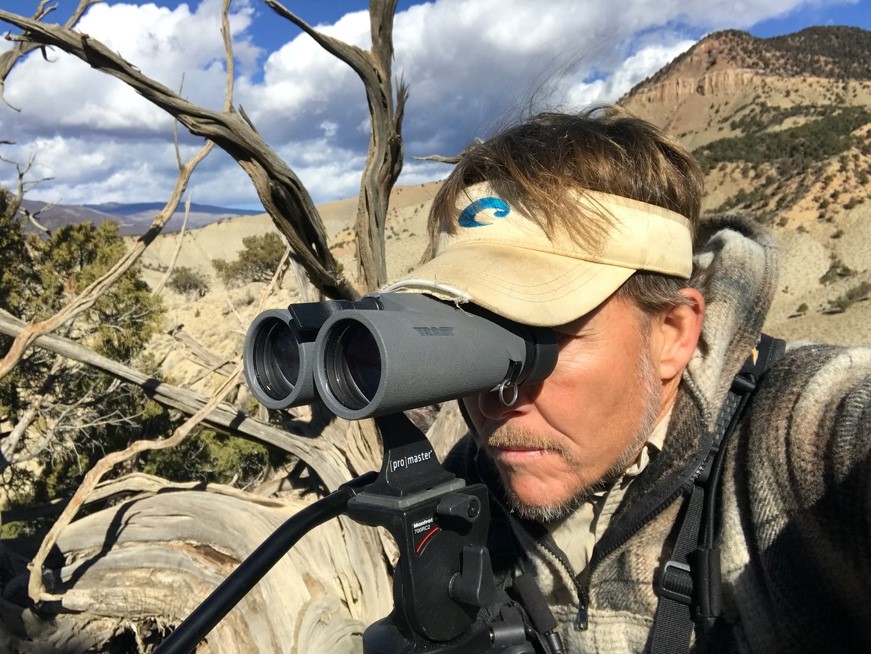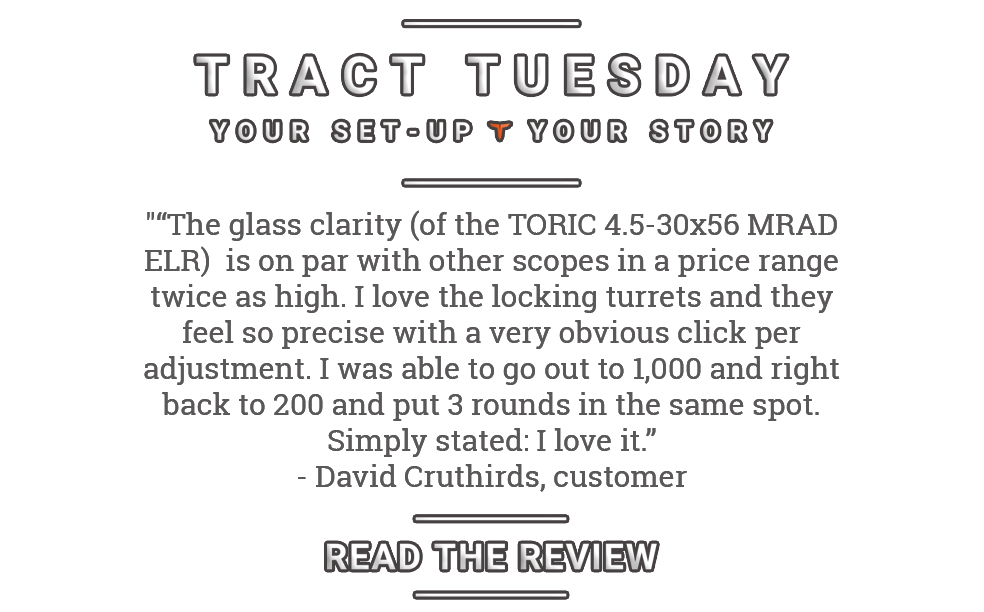To continue the discussion on how to decide what size binocular is best for you, we look at 10x vs 12x binoculars.
We have entered the 12x binocular market (actually our TORIC bino is a 12.5x50). Which is why we want to continue the discussion of helping you figure out what size is best for you when it comes to 10x versus 12x binoculars. Like we mentioned in a recent blog on 8x versus 10x binoculars, the general consensus among many hunters and shooters is that the higher magnification the better. In many cases this is true. And also there will be many instances in your hunting/outdoor experiences when a lower magnification will serve you better. Let’s dive in.
Field of View: 10x vs 12x Binoculars
Let’s start here because it’s important to determine where you will use the binocular. Field of View (FOV) is the area you can see when looking through a binocular, rifle scope, etc. If you were to look at an object 20 feet away with a 10x power binocular that has a 50mm objective lens, you’ll notice there’s not much of a surface area around said object. Now, do the same with a 12x and you’ll likely only see the object with no surface area around it.
If you’re a deer hunter who spends most of his or her time in the hardwoods, field of view when glassing shorter distances is incredibly important to you. With too high a magnification, you’re bound to overlook or miss deer easing through the limbs and leaves.
On the other hand, if you’re mainly hunting on the Great Plains or areas of the Rocky Mountains that aren’t heavily forested, a 12x binocular will give you the magnification you need to identify animals from long distances. The TORIC 10x50 binocular has an FOV of 304 feet at 1,000 yards versus the TORIC 12.5x50 binocular, which has an FOV of 272 feet at 1,000 yards. At such a long distance, the difference is not great. But when you start getting in close, FOV becomes an important factor.
So, when you require more FOV, go with a 10x binocular. If you need distance, then the 12x binocular is for you.

Weight
Weight is another really important consideration when debating 10x versus 12x binoculars. Typically, the higher the magnification and larger the objective lens means more weight. Whereas most 10x binoculars work well with a harness, the 12x almost always requires a tripod in order to hold it steady. This latter point significantly reduces the versatility of the 12x, which is why we took that factor into consideration when designing the TORIC 12.5x50.
It weighs the same as the TORIC 10x50 at just 32.6 ounces. This is due in large part to making the decision from day one to build our binoculars on a magnesium alloy chassis. While they’re both tripod adaptable, they also harness really well and won’t wear out your neck and shoulders after several days of glassing and hunting.
Eye Relief
According to the Vision Council of America, 64 percent of Americans wear eyeglasses. Google it. If you’re among this bunch, have you ever noticed how your glasses tend to prevent you from seeing the full image through a binocular? Eye relief is what let’s those who wear glasses use a binocular unhindered. Really pay special attention to the eye relief specification on any binocular, especially when considering the higher magnifications like a 12.5x or even 10x.
If you wear eyeglasses, 16mm of eye relief is the absolute minimum so that you’re able to see the entire FOV the binocular was designed to allow. The TORIC 12.5x has 16.6mm of eye relief while the 10x boasts a staggering 19.3mm. Comparatively speaking to most binoculars these sizes, that’s excellent. We understand what it’s like to require eyeglasses and want to ensure that if you’re one 64 percent, we have you covered!
Image Stability
Ever noticed how a high heart rate sends tremors through the body, making it seemingly impossible to hold steady? That’s a very common occurrence while hunting, especially at high altitudes when you’ve sighted an absolute trophy buck or bull. Trying to hold a binocular steady while glassing that animal at 200 yards is not easy.
Many western hunters rely on a tri- or bipod for their binoculars as they glass large expanses just as a birder might use a monopod when spending long days looking up into the trees. So, if you’re using a 12x binocular, which will magnify the image by 12 times, it will also magnify the shake in your hands by 12 times.
[caption id="attachment_616" align="aligncenter" width="720"] 10x vs 12x Binoculars[/caption]
10x vs 12x Binoculars[/caption]
To give you a good idea about what we mean, try this little test next time you can get your hands on both a 10x and 12x binocular. Tack a dollar bill on the wall about 20 feet away and try to read the serial number. Start with a 12x binocular. Oftentimes, you’ll shake so much that the task is nearly impossible. Next, take up a 10x. And while you’ll still notice some shake, you’ll notice that there is much less movement in the 10x.
It’s important to understand that just because the image is bigger doesn’t mean you can verify detail. So the truth is, if you can’t hold a 12x binocular steady, you will actually get better results in the field with an 10x. The advantage of a larger image is sometimes not practical because your every movement is also magnified.
Light Gathering
The incredible design of a human’s eye pupils are what allow us to gather or reject light based on the lighting conditions of our surroundings. Your pupils will open to 5-7mm when the light starts to diminish, hence the reason you can see in the near dark. On the contrary, your pupils will shrink to almost 2mm during bright-light conditions to protect your cornea.
Unfortunately, optics aren’t built that way. The light gathering ability of a binocular is built in and does not change based on lighting conditions. That’s why, before you make the decision to buy, it’s important you know the facts. As you know, the amount of light varies from the time you get in a deer stand at mid-afternoon until dusk when animals tend to move the most.
This being the case, you need a binocular that meets or exceeds the size of your entrance pupil during the time you plan to use it. The TORIC 10x50 will give you 5mm of light vs. 4mm from the 12.5x. We know this by measuring the size of the binoculars exit pupil. The exit pupil is the actual image in the eyepiece as it leaves the binocular to enter your eye.

Exit Pupil Explained
A more technical definition of exit pupil is the diameter of the shaft of light (in millimeters) that exits a binocular’s eyepiece and enters through your eye’s entrance pupil. Exit pupil is calculated by dividing a binocular’s objective size by its magnification. For example, based on the TORIC 10x and 12.5, 50mm/10x = 5mm or 50mm/12.5x = 4mm.
Under bright light, your pupil may contract down to 2mm, causing some of the light that emanates from a 5mm exit pupil to go unused because it’s blocked by the iris (above left in diagram). However, under dawn and dusk conditions, your pupil will dilate up to 5mm or more (above right). Thus, a 10x50 binocular will deliver the more light that your pupillary opening will accept versus the 12.5x50.
Decision Time
Now that you have the facts, it’ll be much easier to determine what size binocular is right for you. If you’re looking for an 8x binocular, read all about the difference here. Or check out our TORIC 8x42. For these conditions and uses, I’d save the $10 and buy the best 8x42 binocular the hunting community has ever seen: the TORIC 8x42 with 377 foot FOV, 19mm of eye relief and 5.25mm exit pupil.

